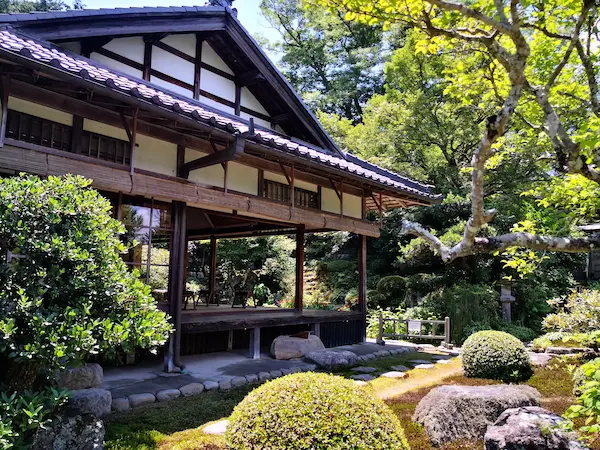Jikkoin Temple in Ohara is a monastery of nearby Shorinin Temple, which used to be the main hall of a sub-temple of Gyozan Taigenji. In addition to this temple and Hosenin Temple, there used to be many other monastery buildings such as Fugenin and Rikakuin.

The Temple’s official WEB site tells the history of the temple as follows.
In 1013, Shorin-in was erected by the monk, Jakugen, the ninth-generatinon disciple of the Tendai monk Ennin (794-864, posthmously named Jikaku Daishi who visited China and introduced shomyo,Buddhist hymns into japan) to desseminate the Tendai sect shomyo. Later cakked Sho-o Daishi) and Ohara came to be looked on as the center og Tendai shomyo with Shorin-in and Raigo-in being the main halls of Gyozan Taigenji. Since Gyozan means Mt. Yu in Ahandong in China where shomyo originated, Ohara is also called Gyozan.
https://jikkoin.com/english/
The all successive resident priests of these temples have devoted themselves to the study of shomyo. Jikko-in, originally locatad in the neighboring Ohara Mausoleum (the tombs of Emperors Gotoba and Juntoku), was mobed to the oresent site in 1919.
The Kyakuden (guest hall), to which visitors to the temple are admitted, was built in 1920. The “Thirty-six Immortal Poets” paintings placed in the banister were painted by a painter of the Kano school in the mid-Edo period, and similar works are also preserved in the Shisendo Hall.
The garden on the south side of the Kyakuden is called “Keishin-en” and was created in the late Edo period. It is a pond garden centered around Shinji Pond, which is fed by the Ritsugawa River. The pond is likened to the Sanzu River, and the mountains on the opposite bank to the Pure Land of Ultimate Bliss.
The garden on the west side of the guest house was formerly part of the Rikakuin temple grounds. And since its merger with Jikkoin, successive abbots have created and maintained the garden to this day. The garden has an open atmosphere with the mountains of Ohara as a borrowed landscape. The “Fudanzakura” cherry tree planted in the center of the garden is a very rare variety. This blooms from early autumn to the following spring. In the fall, visitors can enjoy cherry blossoms and autumn leaves at the same time. And in the cold winter, snow and cherry blossoms can be enjoyed at the same time.




Model courses to visit Jikkoin
Walking tour of Ohara is a good one-day program. You can visit temples in seclusion.
Related articles:
[…] is a temple of the Tendai sect in Ohara. Together with Jikkoin Temple, it is a sub-temple of Shorinin […]
[…] the garden of Jikkoin Temple, you can enjoy cherry blossoms and autumn leaves at the same time. In winter, visitors enjoy […]